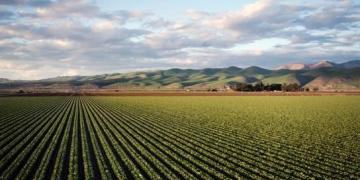EEUU: Water shortages spurring innovation in Columbia Basin
By Heather Smith Thomas, Contributing Writer Farmers rely on water for their livelihoods, but it often costs a lot to get it to the field.

In arid regions, and in the top two potato-producing states of Idaho and Washington, farmers are increasingly utilizing cutting-edge technology to become more efficient and stretch their available water sources.
CRUCIAL CANAL
Central/eastern Washington is one of the most fertile areas in the U.S., growing 23% of the nation’s potatoes. Part of this region’s irrigation water is supplied by canal systems from Grand Coulee Dam, thanks to a massive project that was begun in the 1940s to attract farmers into the area and make 1.1 million acres of that desert land productive.
Some farmers on that land, though, are still waiting for completion of the irrigation project to create the necessary canals. Those farms have been relying on deep wells — which they were given permission to drill as a temporary measure — while they wait.
The aquifer farmers have tapped into is dropping, however, and since it is also the source of water for 25 towns and cities in the area, the urgency to finish the canal system and save the underground water for the towns has become a big issue.
Harold Crose with the Columbia Basin Conservation District is working closely with those farmers on getting water delivered to them via the Odessa Ground Water Replacement Program (OGWRP), which will exchange, acre for acre, deep well irrigation with Columbia Basin Project water from Coulee Dam for 88,000 acres.
The goal is to preserve the declining aquifer for public and municipal benefit, stabilize the regional economy and provide a response to the environmental impacts of the declining Odessa Subarea aquifer.
Most of those farmers are progressive- minded and are doing additional irrigation efficiency to stretch their dwindling water source, Crose said.
“They are working toward better utilization of water and cropping patterns,” Crose said. “Innovations and new technologies help them conserve water.
“The new technologies being used on- farm are probably the highest technical on-farm application of any project in the world. The top three would be water management, nutrient management and pest management and the ways in which these have evolved. On the water management side, the improvements in irrigation technology are tremendous.”
Most of the systems are low-pressure varieties that require minimal pumping capacity, Crose said.
PIVOT POTENTIAL
Crose said the potential of that new tech to affect potato production is vast, with growers turning to innovations such as mobile drip irrigation.
“The technology of the pivot irrigation systems with nozzle configuration is the best,” he said. “A pivot system can be retrofitted and given the ability to act as a drip system, dragging lines. This can push water efficiency up to about 95%, which is incredible.
“We have a couple systems out here now that we are looking at, and they are proving to be very efficient and very effective.”
Embracing the new technology can have many benefits for farmers, Crose said.
“Number one, they can reduce the cost of inputs to the farm, which helps their bottom line. They are using less energy and less water, both of which are expensive,” he said. “Then you get into nutrient management, which is fertilizer for the crops. Farmers are now using drone technology to monitor fields. They also have yield monitors on all their equipment that shows what the crop yields are across the fields.
“If they are getting lower yields in some areas they can focus on those areas and do spot applications of fertilizer with more strategic prescriptive applications.” Grid sampling is an important tool in measuring effectiveness as well as improving crop production and reducing waste, Crose said.
“They can break the field up into grids, based on soil types, past performance and production. It isn’t one size fits all; they are very prescriptive in their approach to nutrient management because it saves money and improves soil health,” he said. “If they are using nitrogen, for instance, if they are over- applying both water and nutrients, the excess gets into the groundwater.”
Farmers can spot-apply nutrients throughout the year through the pivot system, Crose said, and pinpoint zones “where they can speed the system up or slow it down and do more prescriptive application.”
PEST MANAGEMENT
Technological advances can also help farmers find the most efficient ways to control weeds and insect damage.
“They can fly the field with drones and spot areas that are having a problem,” Crose said. “These drones are configured with applicators and can act as miniature crop-dusters. They can find the spot in the field with weeds or insects, using photos that look at spectrometry.
“Those areas have a different reflective characteristic. They can fly over those and spot-apply the necessary herbicide or insecticide.”
This new technology can reduce pesticide use by limiting it to only the areas where needed, he said, which in turn, affects water quality, crop productivity, disease and overall environmental health.
Fuente: https://spudman.com/article/water-shortages-spurring-innovation-in-columbia-basin/




